Academic Publications
Here, you will find a collection of all my articles, including published and last preprint works, up to the end of 2025. Please visit my ORCID or Google Scholar profile for complete and up-to-date information.
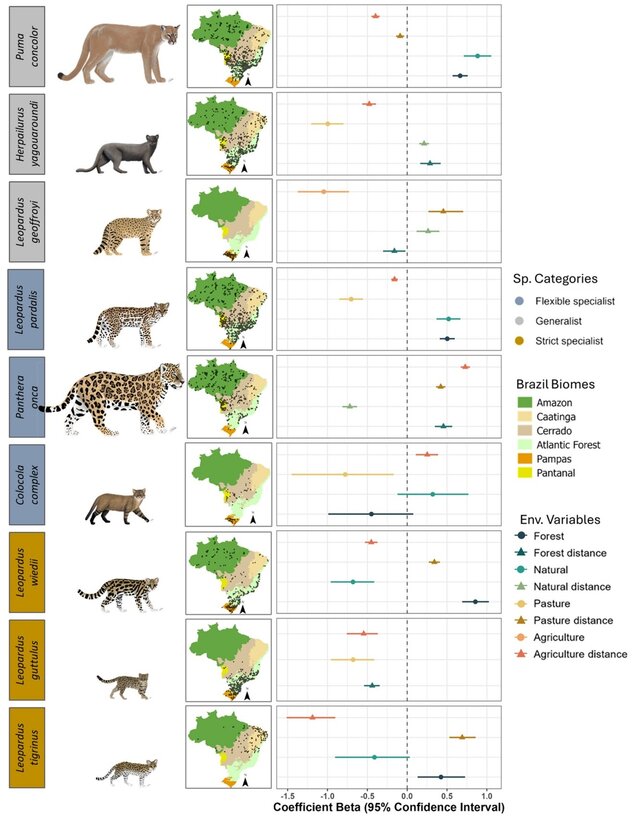
Ecological traits explain wild felid responses to human-modified landscapes in Brazil: an open-data approach for conservation
Understanding how wild felids respond to human-modified landscapes is critical for designing effective conservation strategies. We assessed habitat selection and road sensitivity of nine wild felid species in Brazil using over 14,000 occurrence records from open-access databases. Species were classified into three ecological categories based on habitat plasticity: generalists, flexible specialists, and strict specialists. Results revealed marked interspecific variation in responses to anthropogenic environments and road infrastructure. While generalists like pumas showed tolerance to modified habitats, strict specialists, including margays and tiger cats, demonstrated strong forest dependence. Road effects were species-specific and not always aligned with ecological classification. These findings emphasize that conservation actions must be tailored to species-level responses rather than broad taxonomic approaches.
© Alegre, V.B., Sepulvida, R., Oshima, J.E.F., Azevedo, F.C., Kanda, C.Z., Morato, R.G., & Ribeiro, M.C. (2025). Ecological traits explain wild felid responses to human-modified landscapes in Brazil: An open-data approach for conservation. Biological Conservation, 311, 111461.

Understanding and predicting animal movements and distributions in the Anthropocene
This paper emphasizes the importance of understanding and predicting animal movements and distributions in the Anthropocene, where rapid environmental changes driven by human activities pose challenges to ecosystems. We highlight the need for predictive models that integrate mechanistic insights, moving beyond correlative approaches, to address novel environmental conditions. We stress the value of targeted data collection, interdisciplinary collaboration, and the use of adaptive management frameworks to refine predictions and inform conservation strategies. The study underlines the transformative potential of movement ecology to shift from descriptive science to predictive tools essential for evidence-based policy and conservation in dynamic, human-altered landscapes
© Sara Gomez, Holly English, Vanesa B Alegre, et al. (2025) Understanding and predicting animal movements and distributions in the Anthropocene. Journal of Animal Ecology.

Predator–Prey Movement Interactions: Jaguars and Peccaries in the Spotlight
This study explores the spatial and temporal dynamics of predator-prey interactions between jaguars and white-lipped peccaries (WLP) in the Pantanal, focusing on the influence of landscape structure and prey density. Using GPS data and the Dynamic Interaction Index (DII), the research reveals that interactions occur more frequently at forest-grassland edges and during twilight or nighttime. Increased distances from grasslands and lower WLP densities were key predictors of interaction likelihood, while high densities within peccary core home ranges reduced interactions. The findings emphasize the importance of maintaining transitional habitats to support these interactions, offering valuable insights for conservation strategies in human-modified landscapes.
© Alegre, V. B., de Faria Oshima, J. E., Kanda, C. Z., Jorge, M. L. S., Keuroghlian, A., Morato, R. G., … & Börger, L. (2025). Predator–Prey Movement Interactions: Jaguars and Peccaries in the Spotlight. Biotropica, 57(1), e13423.

Jaguar at the Edge: movement patterns in human-altered landscapes
This study explores the movement patterns of jaguars in human-modified landscapes, focusing on their interactions with forests, agriculture, roads, and drainage areas. The findings reveal that jaguars frequently revisit the edges of these structures, with larger forest patches serving as critical refuges and agricultural areas being largely avoided except for their edges. Jaguars tend to move faster near roads and slower near drainage areas, underscoring the complexity of their spatial behavior in fragmented habitats. These results highlight the importance of conserving large, contiguous forest patches and implementing buffer zones to mitigate human-wildlife conflicts and ensure jaguar survival in dynamic landscapes.
© Alegre, V. B., Kanda, C. Z., de Faria Oshima, J. E., Niebuhr, B. B., Morato, R. G., Thompson, J. J., … & Ribeiro, M. C. (2024). Jaguar at the Edge: movement patterns in human-altered landscapes. Perspectives in Ecology and Conservation, 22(4), 358-366.
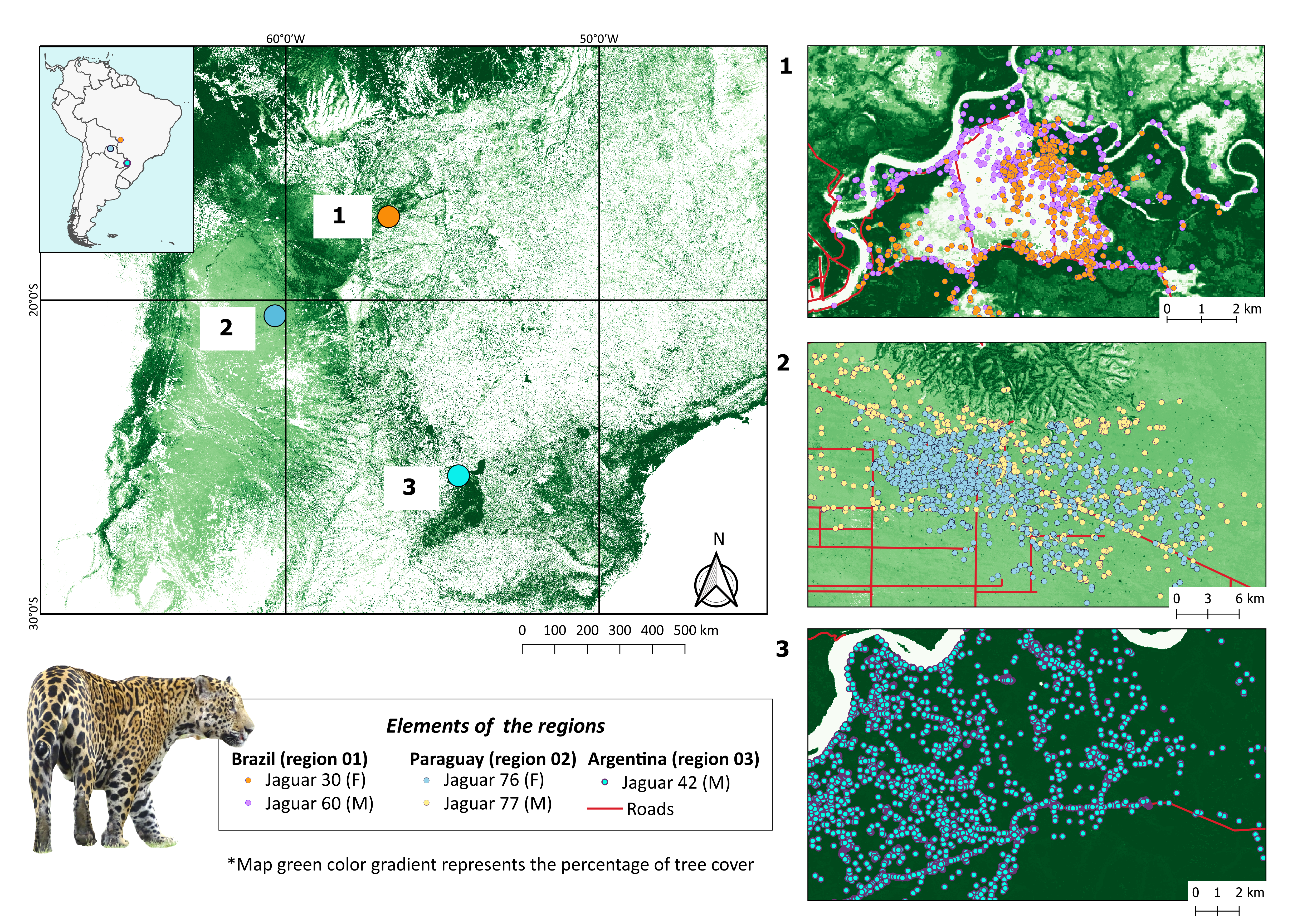
The effect of anthropogenic features on the habitat selection of a large carnivore is conditional on sex and circadian period, suggesting a landscape of coexistence
This study investigates how jaguars adapt their habitat selection in landscapes dominated by human activities, focusing on sex and circadian differences. The findings reveal that while jaguars generally prefer areas with high tree cover and water availability, their interaction with anthropogenic features like croplands, urban areas, and roads varies by gender and time of day. Males tend to use croplands more at night, while females are more likely to be found near urban areas, particularly during nocturnal hours. Both sexes show a notable use of roads despite associated risks, highlighting the importance of these structures in jaguar movement. The research underscores the necessity of preserving natural habitats and implementing effective management strategies for anthropogenic features to ensure coexistence between humans and jaguars across their range.
© Alegre, V. B., Rio-Maior, H., de Faria Oshima, J. E., Niebuhr, B. B., Morato, R. G., & Ribeiro, M. C. (2023). The effect of anthropogenic features on the habitat selection of a large carnivore is conditional on sex and circadian period, suggesting a landscape of coexistence. Journal for Nature Conservation, 73, 126412.
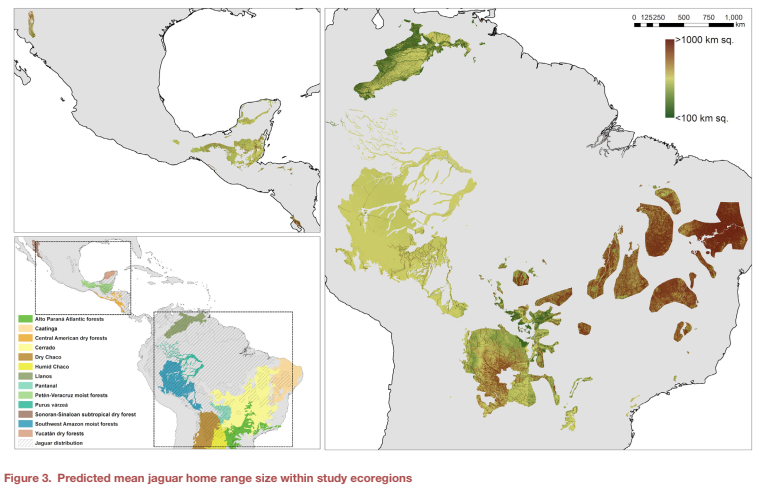
Environmental and anthropogenic factors synergistically affect space use of jaguars
This study investigates the interplay between environmental and anthropogenic factors in shaping jaguar spatial ecology across its range. By analyzing GPS telemetry data from 111 jaguars spanning 13 ecoregions, we reveal that home range size decreases with higher forest cover and productivity but increases with road density. Movement speed is inversely related to forest cover, with no significant differences between sexes. The findings underscore the importance of forested landscapes and highlight roads as barriers to jaguar habitat connectivity. This large-scale analysis provides critical insights for transboundary conservation planning and habitat management for jaguars and other large terrestrial carnivores globally.
© Thompson, J. J., Morato, R. G., Niebuhr, B. B., Alegre, V. B., Oshima, J. E. F., de Barros, A. E., … & Ribeiro, M. C. (2021). Environmental and anthropogenic factors synergistically affect space use of jaguars. Current Biology, 31(15), 3457-3466.

NEOTROPICAL ALIEN MAMMALS: a data set of occurrence and abundance of alien mammals in the Neotropics
This data paper presents a dataset on alien mammals in the Neotropics, including records of their occurrence and abundance. This work is the result of a multinational collaborative effort involving researchers from various institutions across Latin America and the Caribbean. The dataset provides valuable information for conservation, invasive species management, and the assessment of their impacts on local ecosystems, addressing biogeographical, ecological, and management aspects. Additionally, the document highlights the importance of interdisciplinary cooperation in tackling complex environmental challenges.
© Rosa, C. A., Ribeiro, B. R., Bejarano, V., Puertas, F. H., Bocchiglieri, A., & Santos, A. L. B. (2020). Neotropical alien mammals: a data set of occurrence and abundance of alien mammals in the Neotropics. Ecology, 101(11).
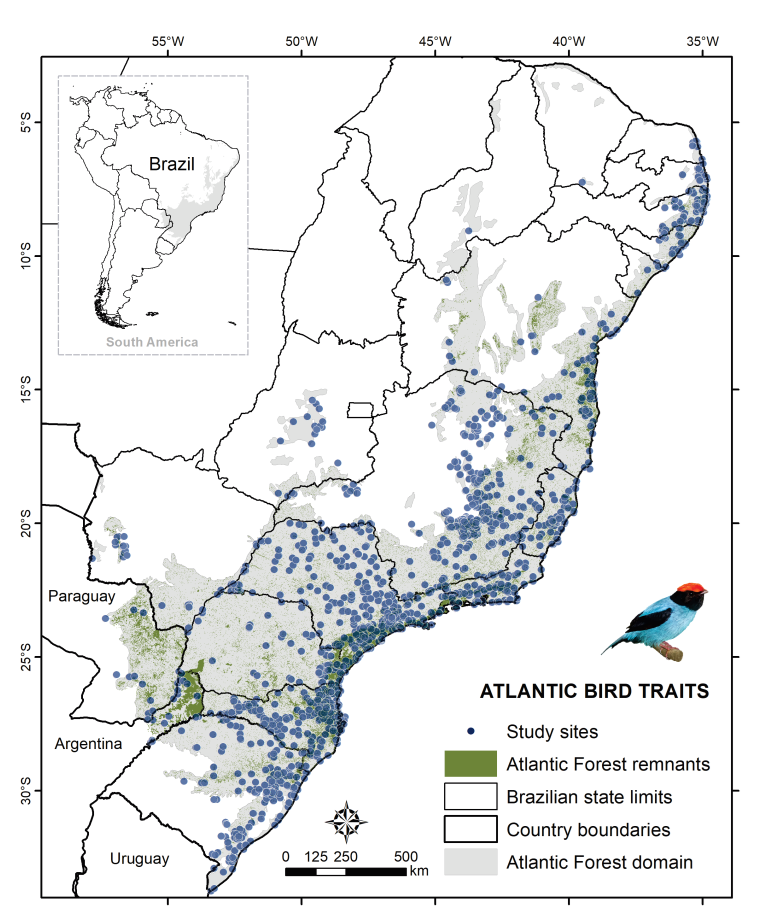
ATLANTIC BIRD TRAITS: a data set of bird morphological traits from the Atlantic forests of South America
The “ATLANTIC BIRD TRAITS” dataset provides extensive information on 44 morphological traits of 711 bird species from the Atlantic Forest of South America. It includes over 67,000 individual records collected between 1820 and 2018, featuring measurements such as body weight, bill length, wing length, and more, along with data on age, sex, reproductive stage, and molt. This resource enables researchers to study how morphological traits vary at individual, species, and community levels in response to environmental and anthropogenic factors. It also provides a robust foundation for studies on functional evolution, phenotypic diversity, and ecological adaptations in one of the world’s most threatened biodiversity hotspots.
© Rodrigues, R. C., Hasui, É., Assis, J. C., Pena, J. C. C., Muylaert, R. L., Tonetti, V. R., … Bejarano Alegre, V., et al. (2018). ATLANTIC BIRD TRAITS: a dataset of bird morphological traits from the Atlantic forests of South America. Ecology, 99, 1-18.
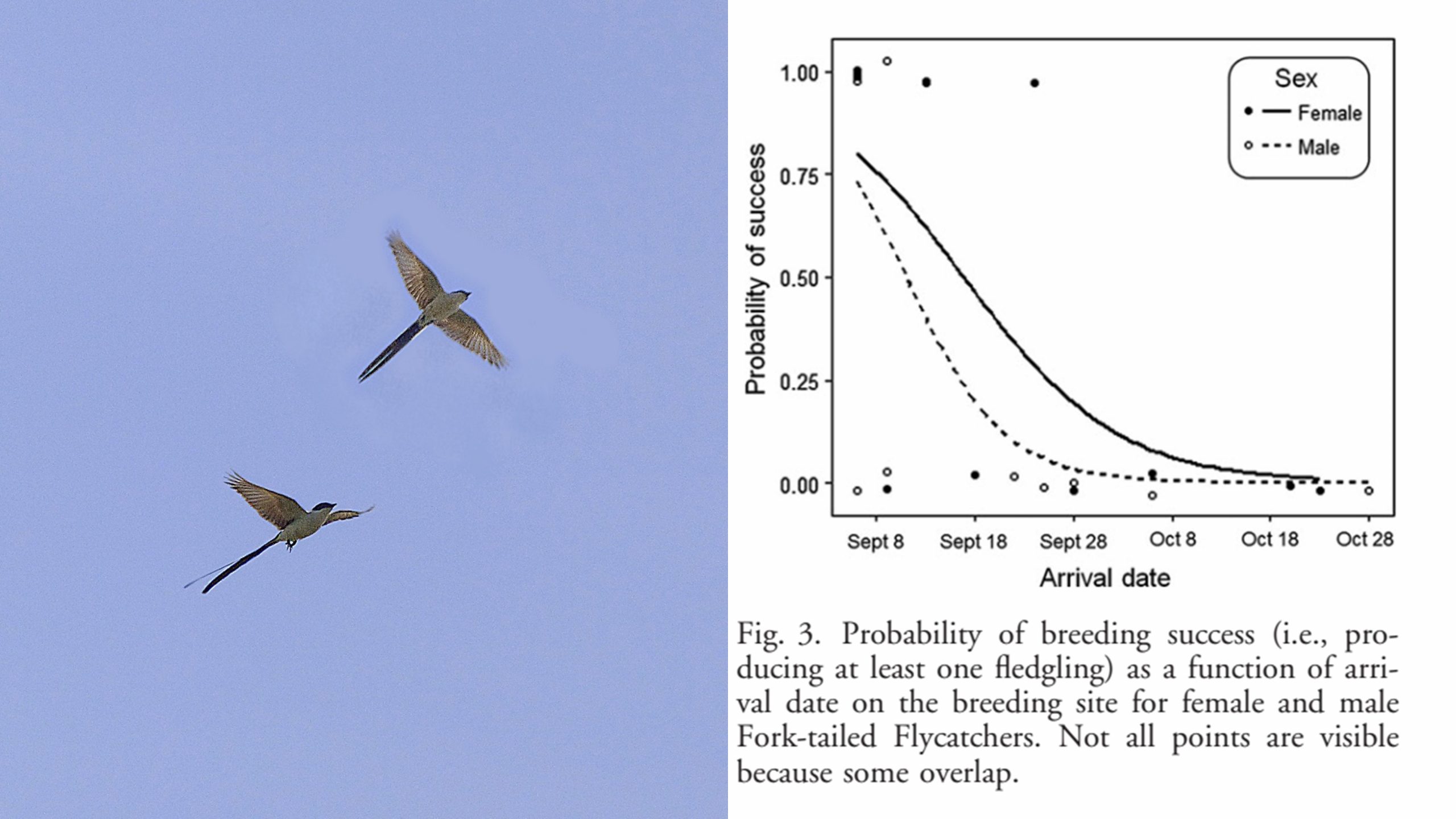
Relationship between arrival timing and breeding success of intra‐tropical migratory Fork‐tailed Flycatchers (Tyrannus savana)
The study examines the relationship between arrival timing at breeding sites and reproductive success in Fork-tailed Flycatchers (Tyrannus savana), an intra-tropical migratory species. The results show that males arrive earlier than females at breeding sites, and those arriving earlier achieve greater reproductive success by acquiring higher-quality territories and mates earlier in the season. Females also benefit from early breeding initiation, but their success is more closely linked to the arrival timing of their mates. This research highlights the occurrence of protandry (earlier male arrival) in intra-tropical migratory birds and emphasizes how environmental changes can influence these species’ reproductive and migratory phenology.
© Bejarano, V., & Jahn, A. E. (2018). Relationship between arrival timing and breeding success of intra‐tropical migratory Fork‐tailed Flycatchers (Tyrannus savana). Journal of Field Ornithology, 89(2), 109-116.

Molting while breeding? Lessons from New World Tyrannus Flycatchers
The study investigates the relationship between feather molt and breeding in New World Tyrannus flycatchers, focusing on potential trade-offs between these energetically costly activities. Analyzing 219 individuals, the study found that only one bird molted flight feathers while breeding, suggesting that simultaneous molt and reproduction are highly energy-intensive. However, some flycatchers molted body feathers during breeding, with clutch size and sex significantly influencing molt intensity. Larger clutch sizes were associated with lower molt intensity in males but not in females. These findings highlight latitudinal differences, as males at higher latitudes showed reduced body molt during breeding due to larger clutch sizes. The study emphasizes the need for further research on sex-specific trade-offs and how environmental and physiological factors influence these critical life history strategies.
© Jahn, A. E., Bejarano, V., Guzmán, M. B., Brown, L. M., Carvalho Provinciato, I. C., Cereghetti, J., … & Tuero, D. T. (2017). Molting while breeding? Lessons from new world Tyrannus flycatchers. Journal of Ornithology, 158, 1061-1072.

Movement ecology research to advance conservation of South America's grassland migratory birds
The article focuses on the movement ecology of South America’s grassland migratory birds, emphasizing their critical role in grassland ecosystems. It highlights how rapid habitat changes—driven by agriculture, urbanization, and climate change—threaten these species. The study underscores the lack of basic biological data on these birds, such as migration routes, population dynamics, and wintering areas, which hinders effective conservation efforts. The authors propose leveraging modern movement ecology theories and technologies to understand these species’ full annual cycles, enabling targeted conservation and management strategies to address threats at local and regional scales.
© Jahn, A. E., Bejarano, V., Cueto, V. R., Di Giacomo, A. S., & Fontana, C. S. (2017). Movement ecology research to advance conservation of South America’s grassland migratory birds. Perspect. Ecol. Conserv. 15, 209–215.

Intra-tropical migration and wintering areas of Fork-tailed Flycatchers (Tyrannus savana) breeding in São Paulo, Brazil
The study reveals that Fork-tailed Flycatchers (Tyrannus savana) have larger clutch sizes in temperate latitudes than tropical ones, attributed to lower predation rates and greater resource availability in temperate regions. Birds breeding in São Paulo migrate northwest to overwintering areas in northern South America, such as the Amazon and Orinoco Basin, at an average speed of 69 km/day in the fall and 129 km/day in the spring, with spring migration being faster. Some birds use multiple overwintering areas, while others remain sedentary. This study highlights how environmental conditions and latitudinal gradients influence reproductive and migratory strategies, emphasizing the importance of these areas for species conservation.
© Jahn, A. E., Seavy, N. E., Bejarano, V., Guzmán, M. B., Provinciato, I. C. C., Pizo, M. A., & MacPherson, M. (2016). Intra-tropical migration and wintering areas of Fork-tailed Flycatchers (Tyrannus savana) breeding in São Paulo, Brazil. Revista Brasileira de Ornitologia, 24, 116-121.

Drivers of clutch-size in Fork-tailed Flycatchers (Tyrannus savana) at temperate and tropical latitudes in South America
This study examines how the clutch size of the Fork-tailed flycatcher (Tyrannus savana) varies between temperate and tropical latitudes in South America. Results show that birds in temperate regions have larger clutches than those in tropical areas. This difference is attributed to lower predation rates, greater resource availability, and favourable environmental conditions in temperate zones. In contrast, tropical regions with higher predation pressure and resource limitations lead birds to invest less in each reproductive event. The study highlights how avian reproductive strategies adapt to environmental and latitudinal gradients, providing valuable insights into the ecological influences shaping species’ life-history traits.
© Jahn, A. E., Tuero, D. T., Mamani, A. M., Bejarano, V., Masson, D. A., & Aguilar, E. (2014). Drivers of clutch-size in Fork-tailed Flycatchers (Tyrannus savana) at temperate and tropical latitudes in South America. Emu-Austral Ornithology, 114(4), 337-342.
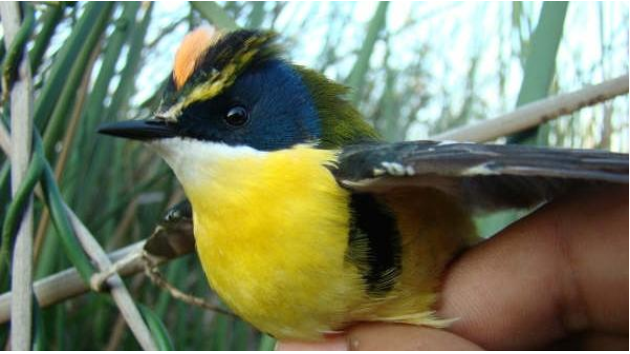
Record of the Many-Colored Rush-Tyrant (Tachuris rubigastra). Department of Santa Cruz, Bolivia
This article documents the first record of Tachuris rubrigastra in the Santa Cruz Department, Bolivia, specifically in the Parque Regional Lomas de Arena. It describes the sighting and capture of an individual on July 10 and 18, 2008, respectively, in a habitat of Schoenoplectus californicus reeds. This record is significant as it represents the lowest altitude reported for the species in Bolivia and may be attributed to erratic movement, as previous studies in the area had not reported its presence.
© Aponte, M. A., Bejarano, V., Conde, L., Delgadillo, W., & Angel, M. 2009. Registro de Tachuris rubigastra en el departamento de Santa Cruz, Bolivia.

